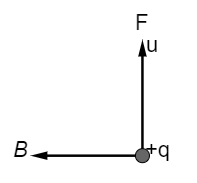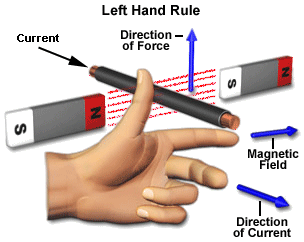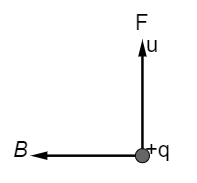
In the above-shown figure, the direction of the magnetic force and magnetic field is given then find out the direction of the particle velocity v.

A) To the right.
B) Downward in the plane of the page
C) Upward in the plane of the page
D) Out of the plane of the page
E) Into the plane of the page.
Answer
141.3k+ views
Hint: For the motion of a charged particle in a magnetic field, the magnetic field vector $B$, the velocity of the particle vector $v$, and the magnetic force vector $F$ that exerted on the particle are all perpendicular to each other.
Complete answer:
The right-hand rule of Fleming states that, to find the direction of the magnetic force on a positive charge, the thumb of the right-hand point in the direction of the velocity of the particle $v$, the fingers in the direction of the magnetic field ($B$), and the force ($F$) is directed perpendicular to the right-hand palm.

The magnetic force on a charged particle with positive charge $q$ moving in a magnetic field $B$ with a velocity $v$ (at angle $\theta $ to $B$) is –
\[\overrightarrow F = qvB\sin \theta \]
\[ \Rightarrow \overrightarrow F = q(\overrightarrow v \times \overrightarrow B )\]
Therefore we can say, force is the cross product of $B$ and $v$ and hence Force is in the perpendicular plane of velocity and magnetic field.
Hence In the figure,

the direction of the magnetic field and force are given. Now if we apply Fleming right-hand rule the direction of the particle velocity will be into the plane of the page.
Hence, the option (E) is the correct answer.
Note: Fleming's rules are applied for determining the relation between the directions of magnetic field, electric current and velocity of a conductor.
There are two rules,
Fleming's left-hand rule for motors which applies for an electric current induces motion in the conductor in the presence of magnetic fields known as Lorentz force.
Fleming's right-hand rule for generators, which applies for a conductor moving through a magnetic field, has an electromotive force induced in it as a result known as Faraday's law of induction.
Complete answer:
The right-hand rule of Fleming states that, to find the direction of the magnetic force on a positive charge, the thumb of the right-hand point in the direction of the velocity of the particle $v$, the fingers in the direction of the magnetic field ($B$), and the force ($F$) is directed perpendicular to the right-hand palm.

The magnetic force on a charged particle with positive charge $q$ moving in a magnetic field $B$ with a velocity $v$ (at angle $\theta $ to $B$) is –
\[\overrightarrow F = qvB\sin \theta \]
\[ \Rightarrow \overrightarrow F = q(\overrightarrow v \times \overrightarrow B )\]
Therefore we can say, force is the cross product of $B$ and $v$ and hence Force is in the perpendicular plane of velocity and magnetic field.
Hence In the figure,

the direction of the magnetic field and force are given. Now if we apply Fleming right-hand rule the direction of the particle velocity will be into the plane of the page.
Hence, the option (E) is the correct answer.
Note: Fleming's rules are applied for determining the relation between the directions of magnetic field, electric current and velocity of a conductor.
There are two rules,
Fleming's left-hand rule for motors which applies for an electric current induces motion in the conductor in the presence of magnetic fields known as Lorentz force.
Fleming's right-hand rule for generators, which applies for a conductor moving through a magnetic field, has an electromotive force induced in it as a result known as Faraday's law of induction.
Recently Updated Pages
Young's Double Slit Experiment Step by Step Derivation

Difference Between Circuit Switching and Packet Switching

Difference Between Mass and Weight

JEE Main Participating Colleges 2024 - A Complete List of Top Colleges

JEE Main Maths Paper Pattern 2025 – Marking, Sections & Tips

Sign up for JEE Main 2025 Live Classes - Vedantu

Trending doubts
JEE Main 2025 Session 2: Application Form (Out), Exam Dates (Released), Eligibility, & More

JEE Main 2025: Derivation of Equation of Trajectory in Physics

A point charge + 20mu C is at a distance 6cm directly class 12 physics JEE_Main

JEE Main Exam Marking Scheme: Detailed Breakdown of Marks and Negative Marking

Learn About Angle Of Deviation In Prism: JEE Main Physics 2025

Electric Field Due to Uniformly Charged Ring for JEE Main 2025 - Formula and Derivation

Other Pages
JEE Advanced Marks vs Ranks 2025: Understanding Category-wise Qualifying Marks and Previous Year Cut-offs

Electric field due to uniformly charged sphere class 12 physics JEE_Main

JEE Main 2025: Conversion of Galvanometer Into Ammeter And Voltmeter in Physics

Degree of Dissociation and Its Formula With Solved Example for JEE

Dual Nature of Radiation and Matter Class 12 Notes: CBSE Physics Chapter 11

Formula for number of images formed by two plane mirrors class 12 physics JEE_Main




